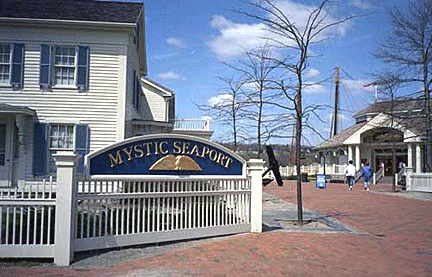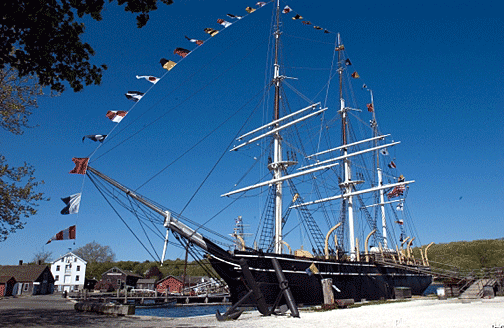|
| |
LONG
AGO IS NOT FAR AWAY AT MYSTIC SEAPORT
by Bob Brooke
 Get lost in time. Forget
the hassles of living in our fast-paced society and step back to the
19th century, even for just a few hours. The past comes to life at
Mystic Seaport. Like the images in old photographs, the Seaport will
take you back to an earlier time when ships and the sea were the
dominant elements of coastal New England life. Get lost in time. Forget
the hassles of living in our fast-paced society and step back to the
19th century, even for just a few hours. The past comes to life at
Mystic Seaport. Like the images in old photographs, the Seaport will
take you back to an earlier time when ships and the sea were the
dominant elements of coastal New England life.
Founded in 1929, Mystic Seaport Museum (not to
be confused with the town of Mystic) is known worldwide as a center for
the collection and preservation of historic ships, boats, maritime arts
and artifacts. At the same time, it's one of the nation's
top tourist attractions.
Settlers moving into the Mystic area in the mid-18th century found an
abundance of timber, sheltered water, and flat land, all
ideal for
shipbuilding. By the middle of the next century, ship and boat yards
lined the six-mile Mystic River. It's on the site of such a shipyard
that the present Mystic Seaport Museum is built.
Begun by three residents of Mystic—Dr. Charles K. Stillman,
Edward E. Bradley and Carl C. Cutler—as a museum and
preservation society call the Marine Historical Association, Inc.,
Mystic Seaport survived more as a center for restoration and research
than a tourist attraction until 1974, when its name was changed to read
as it does now.
Today, it consists of over 60 historic buildings
(all moved from their original locations), four major vessels,
more than 300boats, a research library, a planetarium, and substantial
collections of maritime artifacts and an extensive educational program
to keep the story of the sea alive for generations.
When you step through the modern entrance building, it's
like stepping
through a time portal, for you're immediately transported into the
fascinating world of 19th-century seafaring America.
Time seems to slow down here. Walking is the preferred mode
of travel. Stroll the village streets. Peek into historic New
England homes and maritime trades buildings, all seemingly untouched by
time.
 Your first stop should be the whaleship CharlesW. Morgan, a whaling ship
built in 1841, anchored permanently in the Mystic River. Go below and
see the captain's cabin and the crew's fo'c'sle, where the men lived on
voyages as long as five years. Watch as crewman, dressed in 19th-century
sailing garb high in the rigging, unfurl the mighty sails that drove the
Morgan, America's sole surviving wooden whaling ship, through the cold
waters of the North Atlantic. Afterwards, walk
the decks of the square-rigged ship Joseph Conrad, built in Denmark in
1882, and now serving as the center of the Seaport's sail-training
program. Let your imagination soar as you relive the days of Grand Banks
fishing aboard the two-masted Glouscester fishing schooner L.A. Dunton. Your first stop should be the whaleship CharlesW. Morgan, a whaling ship
built in 1841, anchored permanently in the Mystic River. Go below and
see the captain's cabin and the crew's fo'c'sle, where the men lived on
voyages as long as five years. Watch as crewman, dressed in 19th-century
sailing garb high in the rigging, unfurl the mighty sails that drove the
Morgan, America's sole surviving wooden whaling ship, through the cold
waters of the North Atlantic. Afterwards, walk
the decks of the square-rigged ship Joseph Conrad, built in Denmark in
1882, and now serving as the center of the Seaport's sail-training
program. Let your imagination soar as you relive the days of Grand Banks
fishing aboard the two-masted Glouscester fishing schooner L.A. Dunton.
Demonstrations occur almost hourly. Watch skilled hands working at the
forge and in the boat builder's shop. Stop by and chat with the
woodcarver. He'll tell you how he makes his living carving figureheads
for the ships.
Or marvel at the scores of indoor exhibits of ship models, figureheads,
scrimshaw, old photos, navigational instruments and thousands of
everyday items from life at sea and ashore. Four of the buildings--the
chapel, the school, the tavern, and the coast guard station--are now
audio animated. As you cross the threshold of each historic structure,
the sounds of that building are heard. For instance, when you enter the
chapel, the minister gives a fire-and-brimstone sermon and in the coast
guard station, the men are discussing how they're going to rescue the
occupants of a ship wrecked in a storm offshore. A detailed daily
calendar of events is given to you as you enter. There's time enough for
everything.
You'll find activities to delight your children as well. The
children's museum explains life at sea and shows kids how whales
were hunted for their oil. Daily film and planetarium programs highlight
navigational talks, and you even join in singing sea chanteys.
If you've been touring since opening time, it's time for lunch. For a
quick bite, stop at the Galley, a large fast-food
restaurant serving everything from deep-fried scallops to
hamburgers, as well as breakfast from 10:30 a.m. For a more leisurely
lunch in formal surroundings, try the Seaman's Inne where fine food is
served in 19th-century Victorian elegance.
The Seaport hosts many special events throughout the year. There's the
traditional Decoration Day (Memorial Day)
celebration, an Antique and Classic Boat
Rendezvous, a rousing all-American Independence Day festival, and a
Photo Day, when you can get photographed with your favorite Mystic
Seaport citizen courtesy of Kodak.
Mystic Seaport is so famous that many people think it's also the town in
which it's located. In fact, it's not even located in Mystic but in
Stonington. This charming New England town on the Mystic River offers a
bit of small-town America where residents are friendly and outgoing.
The Mystic River is still the main focal point of the town. Though the
last full-rigged ship was built here in 1869, you can still see remnants
of that era in the elegant ship captain's houses that line the side
streets. A map with a walking tour of the town is available at the local
tourist office and at many of the restaurants and shops in town.
After a day of exploring the Seaport, take the time to sit and watch the
boats on the river from one of several restaurants which line its banks.
Enjoy a lobster dinner at the Flood Tide Restaurant or a delicious pizza
at--you guessed it--Mystic Pizza!< Back to
Travel Articles
Go to the next travel article > |
|
